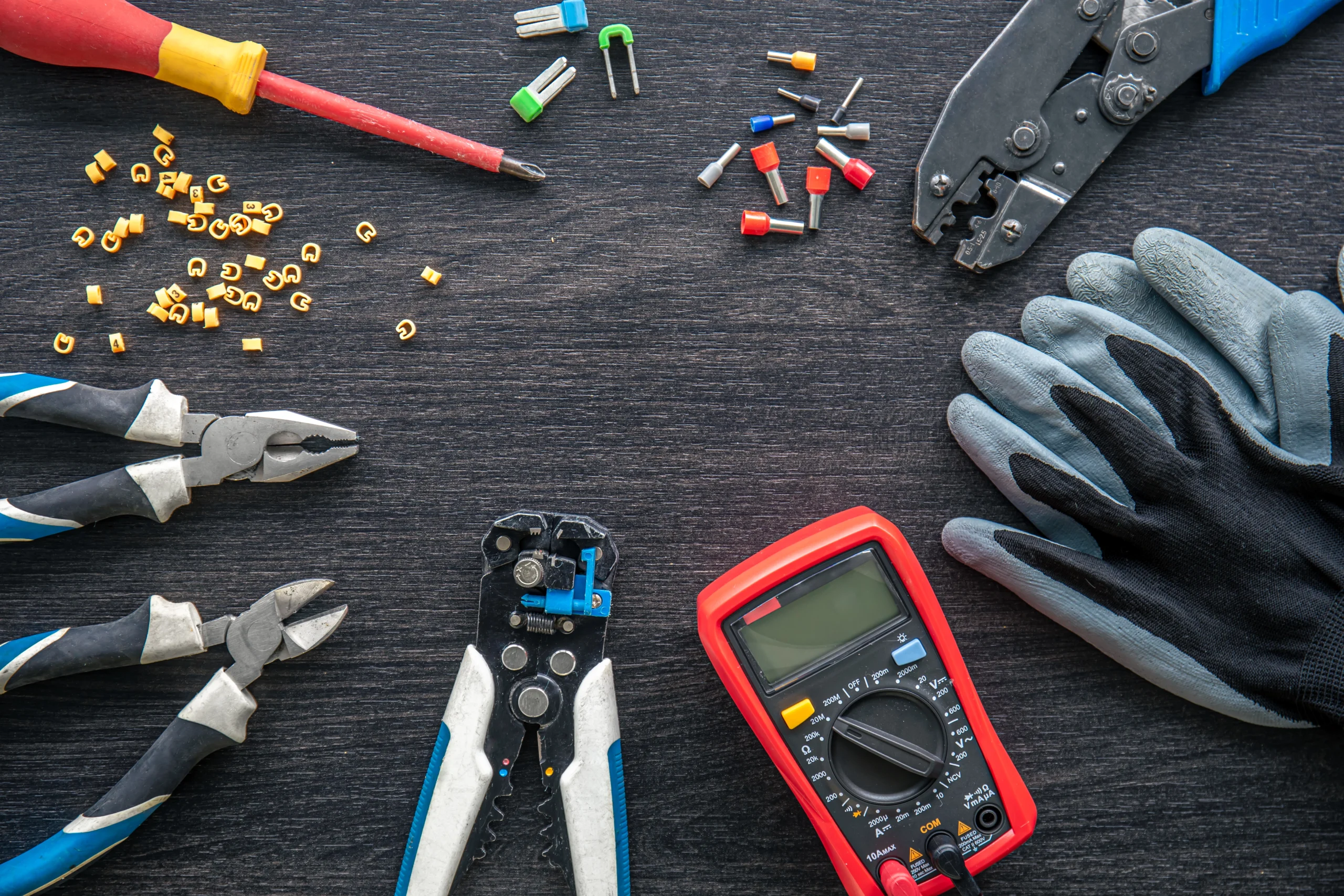Top 10 Electrical Tools Every Homeowner Should Own
Introduction: Taking Charge of Your Home Starts With the Right Tools
You’ve probably faced that awkward moment—standing in the dark after a blown fuse or fumbling with exposed wires on a weekend project. You may have reached for a screwdriver only to realize it’s not insulated, or worse, discovered you have no way to test if the outlet is even live.
Sound familiar?
Owning a basic set of electrical tools isn’t just about being « handy »—it’s about safety, convenience, and control over your home’s electrical well-being. Whether you’re swapping out a light switch, adding an outlet, or just wanting to avoid a costly electrician call for minor repairs, the right tools give you freedom and peace of mind.
Let’s walk through the top 10 electrical tools you should absolutely have in your toolkit.
Table of Contents
Why You Need Electrical Tools at Home
Electrical issues don’t wait for permission. A flickering light, a buzzing outlet, or a dead circuit—they come without warning. And while you don’t need to become a licensed electrician, having essential tools helps you:
- Save money on small repairs and diagnostics
- Prevent accidents by catching issues early
- Handle emergencies before they escalate
- Learn valuable DIY skills over time
Think of it this way—would you drive without a spare tire? Then why live in a home without basic electrical tools?
Tool #1: Voltage Tester – Your First Line of Safety
Why you need it:
Before touching any wires, you need to know if they’re live. A non-contact voltage tester lets you check without any physical contact—making it perfect even if you’re new to electrical work.
What to look for:
- Audible and visual indicators
- Auto shut-off features
- Pocket-sized design for quick access
Bonus Tip: Always test the tester before and after use—just to ensure it’s working properly.

Tool #2: Digital Multimeter – Diagnose Like a Pro
What it does:
Measures voltage, current (amps), and resistance (ohms). Whether you’re testing a faulty appliance, checking battery health, or diagnosing a dead circuit, a digital multimeter is your go-to.
Key features:
- Auto-ranging modes (so you don’t need to guess settings)
- Backlit screens for working in dark areas
- Safety-rated probes
It’s the Swiss army knife of electrical testing.

Tool #3: Wire Strippers – Clean Cuts, No Hassle
Cutting and stripping wires by hand? Not only is it frustrating—it’s unsafe. A wire stripper allows you to remove insulation without damaging the copper wire inside.
Choose one that has:
- Multiple gauge settings
- Integrated crimper and cutter
- Comfortable grip
It’s small, simple, and saves tons of time (and fingertips).

Tool #4: Circuit Breaker Finder – No More Guessing Games
How many times have you flipped random breakers just to figure out which one controls the living room?
This tool solves that.
A circuit breaker finder tells you exactly which breaker matches which outlet—without trial and error.
Look for:
- Plug-in transmitter with easy-read display
- Tone-based indicators
- GFCI test buttons (as a bonus)

Tool #5: Electrical Tape – Safety in a Roll
You might not think of electrical tape as a tool, but it’s essential for safe wiring.
It does more than cover exposed copper:
- Provides insulation
- Prevents shorts and sparks
- Withstands heat and moisture
Stick to high-grade, flame-retardant brands. Cheap tape peels over time and may cause issues down the line.

Tool #6: Insulated Screwdriver Set – Because Not All Screwdrivers Are Equal
Regular screwdrivers are a no-go when working near live wires. You need ones with insulated handles rated for electrical safety.
Must-haves:
- VDE certification (up to 1,000 volts)
- Multiple tips (flat, Philips, Torx)
- Magnetic heads for tight spots
This isn’t just about functionality—it’s about keeping your hands and heart safe.

Tool #7: Utility Knife – More Than a Cutter
When working on wiring, a sharp utility knife is invaluable. Whether you’re trimming insulation, cutting zip ties, or prepping cables, this tool gives you control.
Choose models with:
- Retractable blades
- Rubberized grip
- Blade storage built-in
Keep it sharp. A dull knife is more dangerous than a sharp one.

Tool #8: Fish Tape – Navigate the Walls
Running wire through walls or ceilings without ripping them apart? That’s where fish tape comes in.
It allows you to:
- Pull wires through tight conduits or PVC
- Snake around corners behind drywall
- Reduce time spent fishing with coat hangers (yes, we’ve all been there)
Available in steel or fiberglass, it’s a must for renovations or new installs.

Tool #9: Wire Nuts & Connectors – Secure Your Work
Connecting two wires by twisting them isn’t just outdated—it’s unsafe. Wire nuts and push-in connectors offer secure, lasting joins.
Tips:
- Use color-coded nuts to match wire size
- Twist clockwise and test for firmness
- Use clear push-in connectors for visibility
Always double-check tightness. A loose wire is a fire hazard.

Tool #10: Headlamp or LED Work Light – See What You’re Doing
No one talks about lighting—but working in the dark is risky. Whether in crawlspaces or behind panels, a headlamp frees up your hands and focuses light where you look.
Look for:
- Rechargeable lithium-ion batteries
- Adjustable beam angles
- Dust and water resistance
Good light makes you faster, safer, and far less frustrated.

Quick Comparison Table – What to Buy and Why
| Tool Name | Use Case | Key Features | Recommended For |
|---|---|---|---|
| Voltage Tester | Detecting live wires | Non-contact, visual alerts | Beginners & experts |
| Digital Multimeter | Measuring electrical values | Auto-ranging, backlight | DIY diagnostics |
| Wire Strippers | Removing wire insulation | Multi-gauge, built-in cutter | All levels |
| Circuit Breaker Finder | Locating breakers | Plug-in transmitter | Homeowners with panels |
| Electrical Tape | Insulating wires | Flame-retardant, elastic | Everyone |
| Insulated Screwdrivers | Safe tightening | VDE rated, magnetic heads | All users |
| Utility Knife | Cutting insulation/tape | Retractable, spare blades | General use |
| Fish Tape | Pulling wires | Flexible, strong | Renovators |
| Wire Nuts | Securing connections | Color-coded, twist-on | Everyday tasks |
| Headlamp | Illuminating dark spaces | Rechargeable, adjustable straps | Night/evening work |
How to Build Your Electrical Tool Kit from Scratch
Starter Checklist:
- All 10 tools listed above
- Tool bag or rolling toolbox
- Spare batteries (for testers and lamps)
- Label maker for circuit panels
Safe Storage Practices:
- Store in a cool, dry space
- Keep tools organized by category
- Clean after use to prevent rust
Pro tip: Avoid leaving tools in hot garages—they degrade faster.
Buying Tips: Choose Tools That Last
Don’t fall for flashy packaging or bargain bins. Your safety depends on quality.
Consider the following:
- Certifications – Look for UL, CE, or VDE ratings
- Brand reputation – Trusted names like Klein Tools, Fluke, and Milwaukee
- User reviews – Check what others say after months of use
- Warranty policies – Longer warranties reflect better build quality
FAQ: Electrical Tools Every Homeowner Should Own
What electrical tools do I really need at home?
At the bare minimum: a voltage tester, digital multimeter, insulated screwdrivers, wire strippers, and electrical tape. These handle 90% of basic electrical fixes.
Is it safe to use these tools without experience?
Yes—as long as you shut off the power, wear gloves, and follow instructions. Tools like non-contact testers are designed with beginners in mind.
Can I do all repairs with these 10 tools?
These tools cover most minor tasks: replacing outlets, switches, fuses, and checking continuity. For major rewiring or panel work, always consult a licensed electrician.
Where should I store my electrical tools?
In a sealed toolbox stored in a dry, cool area. If you have kids, use a locking box for safety.
Conclusion: Be Your Home’s First Responder
You don’t need to be an expert. You just need the right tools and the willingness to learn. With these 10 electrical tools at your side, you’ll have the power (pun intended) to solve common issues, protect your family, and even take pride in your DIY victories.
When a fuse pops, a wire loosens, or a light flickers—you won’t panic. You’ll be ready.


